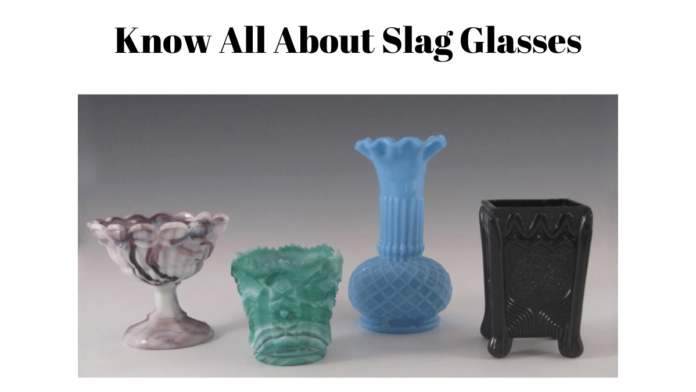Slag glass, also called malachite, marble, or mosaic glass, is a type of moulded glass admired by collectors worldwide for its gentle shifts in colour and transparency. Its attractiveness is enhanced by a fascinating history showcasing glassmakers’ creativity from the past.
This article takes you on a journey through that history and showcases some of the most sought-after types for anyone interested in owning outstanding slag glass pieces.
What is Slag Glass? A Discarded History
Slag glasses are named after a waste product from making steel. When iron ore is melted, a shiny, glassy substance changes color based on the minerals in the iron. This waste looks like slag glass, but whether it is actually in the glass depends on how the glass was made.
In the past, some believed that makers of slag glass added ground-up pieces of this waste to their melted glass to create different colours. As mentioned by the Corning Museum of Glass, another way to make slag glass involves melting down leftover bits of glass from the end of the day at glass factories. Mixing these bits created a look similar to the waste from steel.
No matter the method, slag glass was a clever way to reuse materials that would have been thrown away. This reuse led to unique and varied glass colours. The novelty of slag glass, when it first appeared in the late 1800s, excited those who made and collected glass.
Early English Slag Glass Makers
In the late 1870s, the Sowerby company in England secured one of the earliest patents for its distinctive purple malachite glass, known as slag glass. The glass items made by Sowerby, as well as those by other British manufacturers like Davidson and Greener & Company, remain highly sought after, especially those with the unique brown malachite color.
However, Brown was not the only colour they produced; Sowerby also created glass in a variety of hues, such as bright yellow (giallo), deep blue (Corbin), and soft green (Pomona).
American Slag Glass Makers
In the 1800s, when American companies started making slag glass, they followed the trend set by British firms. Atterbury & Company was one of the first in the U.S. to make these items. They made beautiful things like a lamp base that worked with kerosene from the 1860s to about 1900.
Another company, Challinor, Taylor & Company, was known towards the end of the 1800s for making smaller items for the home, like salt and pepper shakers in different colours. Their designs were so admired that they are now part of collections in some of the most famous museums in the world, including a goblet on display at the Metropolitan Museum of Art in New York.
In the twentieth century, well-known glassmakers like Imperial, Boyd, and Westmoreland continued creating beautiful slag glass pieces. They experimented with various delightful novelties. For example:
- Westmoreland made a Three Kittens Plate and multicoloured, iridescent “Hen on the Nest” covered dishes.
- Boyd specialized in novelty figurines, including an aeroplane design.
- An interesting addition to the slag glass market during this time was Akro Agate, an Ohio-based maker originally famous for marbles. In the 1930s, they shifted to producing pressed slag glass designs, such as these paired vases. Interestingly, they preferred to call their pieces “multi-colours” rather than “slag glass”.
Arts & Crafts Slag Glass and Art Nouveau
Some of the most admired American slag glass from the 1900s came from the Art Nouveau and Arts and Crafts period. Notable creators like Tiffany Studios, Steuben, and Roycroft appreciated how the natural patterns in the glass added to the earthy charm of their work.
Their creations included everything from impressive lamps to smaller items for decoration, such as jewellery holders and photo frames. These works displayed the skilful use of slag glass’s gentle shifts in colour and transparency to create beautiful effects.
How to Know Slag Glass
Slag glass, known for its unique colour variations and opacity, has become widely popular, leading to a large presence of both old and newer pieces in the market. This makes it difficult to distinguish authentic slag glass, which is often characterized by its deep and nuanced colour patterns, similar to marble or alabaster.
Authentic pieces do not just have lines of colour; they show a gentle shift in colour and transparency. On the other hand, fake slag glass items, such as an ashtray from the early 1900s, tend to have a very consistent and even colour throughout.
What is the Worth of Slag Glass?
These brand names and tips will help you find a great piece of slag glass to add to your collection. However, one thing to consider is how much these pieces are worth. Slag glass comes at all prices, just like many other collectables.
The condition and age of the piece are important – newer ones usually cost less than older ones. However, the most important thing affecting the price is who made it: for example, Tiffany Lamps with a signature, like the amazing Dragonfly Lamp, can be sold for a lot of money, while small, fine items like a Boyd train set might only cost a few dollars.
The good thing about such a wide range of prices is that anyone can afford to buy slag glass, no matter their budget. It is perfect for those who want to make a big statement or add something special to their space. So, whether you are looking to invest a lot or just a little, you can find a piece of slag glass that’s just right for you.
Some Questions
What is Slag Glass?
Slag glass is an opaque, pressed glass known for its colourful streaks, which create a marbled effect. It’s often made by mixing different colours of molten glass or by adding slag from iron smelting to the glass.
Where does Slag Glass come from?
The name ‘slag glass’ comes from the byproduct of steel production, slag. When mixed into molten glass, this byproduct gives slag glass its distinctive marbled look.















